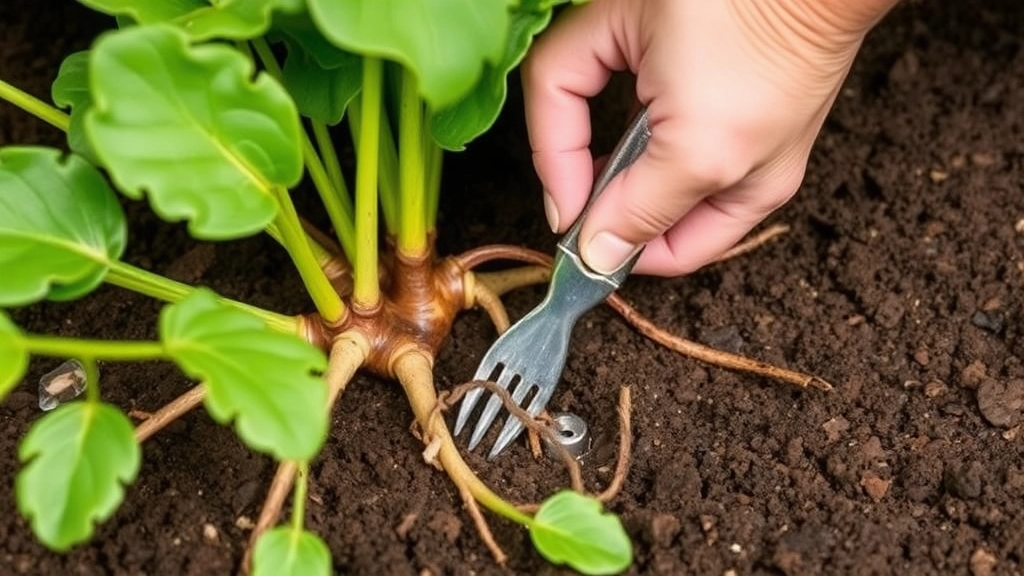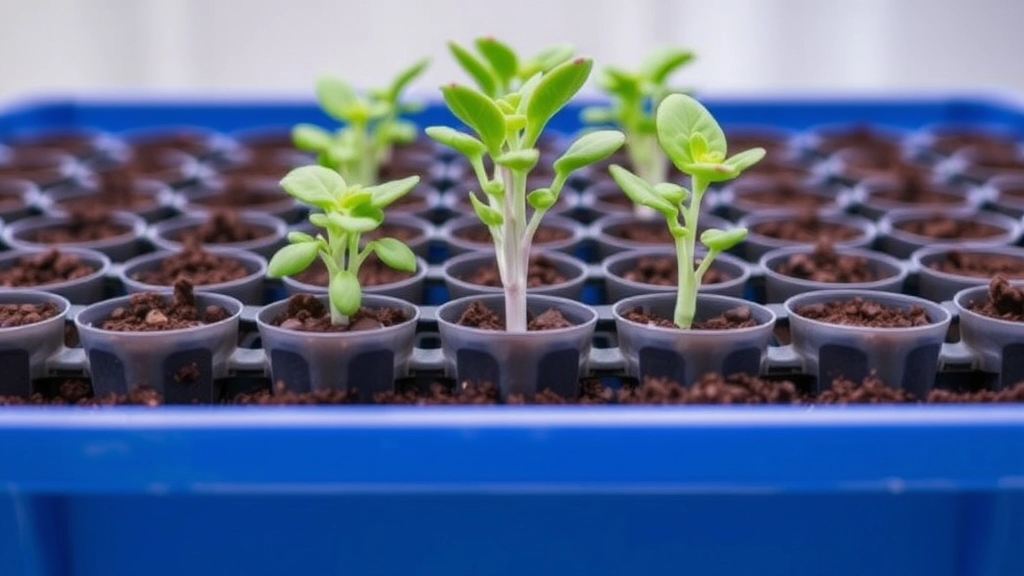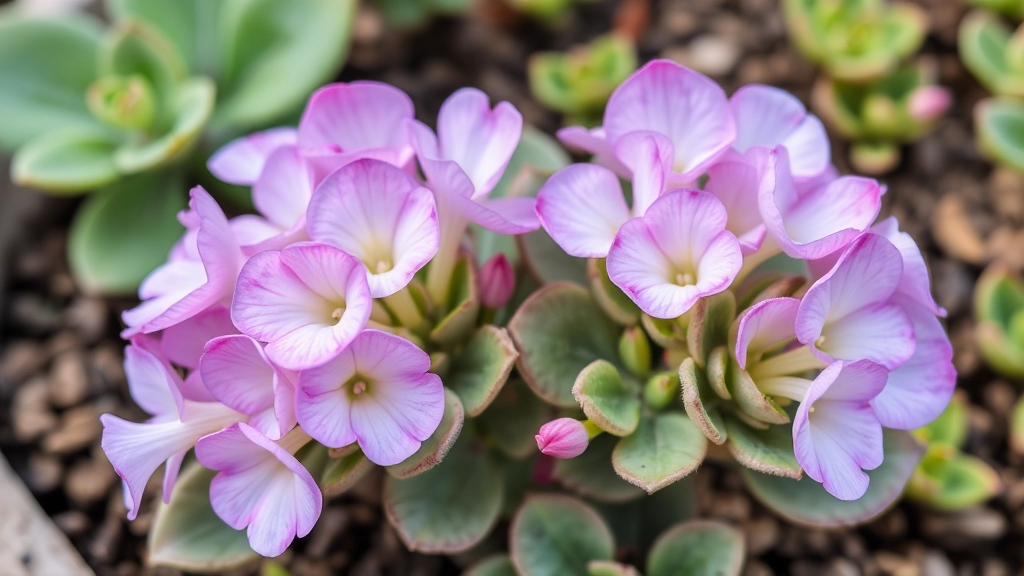Caring for Kalanchoe Lavender Scallops
If you’re looking to care for your Kalanchoe Lavender Scallops, you’ve come to the right place. This guide will walk you through everything from ideal growing conditions to propagation techniques. Whether you’re a seasoned gardener or just starting out, these tips will help you keep your plant thriving.
About Kalanchoe Lavender Scallops
Kalanchoe Lavender Scallops, also known as Kalanchoe fedtschenkoi, are beloved for their unique foliage and easy maintenance. We’ll cover how to water them properly, choose the right soil, and protect them from common pests and diseases. Let’s dive in and make sure your Lavender Scallops flourish!
Ideal Growing Conditions for Kalanchoe Lavender Scallops
Are you struggling to keep your Kalanchoe Lavender Scallops thriving? You’re not alone. Many plant enthusiasts find that creating the perfect environment for these stunning succulents can be a challenge.
Light Requirements
Kalanchoe Lavender Scallops flourish in bright, indirect sunlight.
- Optimal Location: A south-facing window is ideal.
- Avoid Direct Sun: Too much direct sunlight can scorch the leaves.
Temperature Preferences
These plants prefer a warm climate, making temperature control essential.
- Ideal Range: Keep them in temperatures between 20°C to 25°C (68°F to 77°F). For more details, check out the ideal temperature for Kalanchoe Blossfeldiana growth.
- Avoid Cold Drafts: Sudden temperature drops below 10°C (50°F) can stress the plant.
Humidity Levels
While Kalanchoe Lavender Scallops are quite resilient, they thrive in moderate humidity.
- Indoor Humidity: Aim for 40% to 60%.
- Avoid Excess Moisture: High humidity can lead to fungal issues. If you notice issues like white spots, you might want to read about causes and treatments for white spots on Kalanchoe Tomentosa.
Fertilisation
Feeding your Kalanchoe can boost its growth significantly.
- When to Feed: Use a diluted, balanced fertiliser during the growing season (spring and summer).
- Frequency: Fertilising once a month is generally sufficient.
Watering Guidelines: How to Avoid Root Rot

So, you’ve got your Kalanchoe Lavender Scallops, and now you’re wondering how to keep them thriving without drowning them, right?
Watering can be a tricky business, especially when it comes to succulents like these. Too much moisture, and you could be looking at root rot—something no plant parent wants to deal with.
Key Tips to Avoid Root Rot:
- Check the Soil: Always check if the top inch of soil is dry before you water. If it’s still moist, hold off a bit longer.
- Use Well-Draining Pots: Make sure your pot has drainage holes. This allows excess water to escape, preventing soggy roots.
- Watering Schedule: In general, water every 2-3 weeks during the growing season (spring and summer). In winter, you can cut back to once a month.
- Watering Technique: When you do water, give it a good soak until water drains out of the bottom. This ensures the roots are getting the moisture they need.
- Humidity Matters: Kalanchoe Lavender Scallops prefer drier air. If you live in a humid area, you might need to adjust your watering habits.
Real Talk
I remember when I first got my Kalanchoe. I was so excited that I watered it every day. Big mistake! The leaves started to droop, and I panicked. After some research, I learned that less is more.
Now, I keep a moisture meter handy. It’s a game changer!
Choosing the Right Soil for Lavender Scallops
When it comes to nurturing Kalanchoe Lavender Scallops, the right soil can make all the difference.
Many plant enthusiasts wonder: What type of soil is best for my Lavender Scallops?
The answer lies in understanding their unique needs.
Propagation Techniques for Successful Growth

As we explore the propagation techniques for Kalanchoe Lavender Scallops, it’s essential to understand how to expand your collection effectively. Many plant enthusiasts often wonder how to grow more of these stunning plants without the need for purchasing new ones.
1. Leaf Cuttings
One of the most popular methods for propagating Kalanchoe Lavender Scallops is through leaf cuttings. This technique is straightforward and can yield great results.
- Select Healthy Leaves: Choose mature, healthy leaves from the parent plant.
- Cut and Dry: Use a clean, sharp knife to cut the leaves. Allow them to dry for a few days to form a callus.
- Planting: Once dried, place the cut end in well-draining soil.
- Water Sparingly: Mist lightly and keep the soil slightly moist until roots develop.
2. Offsets
Kalanchoe plants often produce offsets, or “pups,” which can be separated and replanted.
- Identify Offsets: Look for small plants growing at the base of the parent plant.
- Separation: Gently twist or cut the offset away from the main plant.
- Replanting: Plant the offset in its own pot filled with suitable soil and water lightly.
3. Seed Propagation
Though less common, growing Kalanchoe from seeds can be rewarding.
- Seed Collection: Collect seeds from mature flowers once they have dried.
- Sowing: Scatter seeds on the surface of moist soil without covering them.
- Humidity: Cover with a plastic dome to maintain humidity until germination occurs.
By mastering these propagation techniques, you can easily grow your Kalanchoe Lavender Scallops collection. Each method offers a unique way to expand your garden and share these beautiful plants with friends.
As we delve deeper into caring for your Kalanchoe Lavender Scallops, understanding potential pests and diseases is essential for maintaining their health.
### Common Pests
Kalanchoe Lavender Scallops can fall prey to several pests that may hinder their growth. Here are the most frequent offenders:
– **Mealybugs**: These tiny, white, cotton-like insects cluster in leaf joints and can cause leaf drop.
– **Spider Mites**: Often appearing as tiny red or black specks, spider mites thrive in dry conditions and can create webbing on the leaves.
– **Aphids**: Small and green, these pests suck sap from the plant, leading to stunted growth and curled leaves.
### Common Diseases
In addition to pests, your Kalanchoe may encounter various diseases. Awareness of these issues can help you take preventive measures:
– **Root Rot**: Often caused by overwatering, root rot manifests as yellowing leaves and a foul smell from the soil.
– **Powdery Mildew**: This fungal disease appears as a white powdery coating on leaves, often exacerbated by high humidity.
– **Leaf Spot**: Characterized by dark spots on the leaves, this condition can be caused by fungal infections or poor air circulation.
### Prevention and Treatment
To keep your Kalanchoe Lavender Scallops thriving, consider these preventive measures:
– **Regular Inspections**: Check your plants weekly for signs of pests or disease.
– **Proper Watering**: Avoid overwatering to prevent root rot.
– **Good Air Circulation**: Ensure your plants are not overcrowded, allowing air to flow freely around them.
– **Natural Remedies**: Use insecticidal soap or neem oil for pest control. For fungal issues, a diluted mixture of water and baking soda can be effective.
By being proactive about pests and diseases, you can keep your Kalanchoe Lavender Scallops healthy and vibrant. For more detailed care tips, you might find the [Kalanchoe Flapjack Paddle Plant Care & Propagation Tips](https://planthq.org/kalanchoe-flapjack-paddle-plant-care-propagation-tips/) and the [Ultimate Guide to Kalanchoe Silver Dollar Care and Propagation](https://planthq.org/ultimate-guide-to-kalanchoe-silver-dollar-care-and-propagation/) particularly useful.
Seasonal Care: Managing Light and Temperature Changes
So, you’ve got your Kalanchoe Lavender Scallops thriving, but what about when the seasons change?
Light Needs:
- Spring and Summer:
- These beauties love bright, indirect sunlight.
- A south or west-facing window is ideal.
- Too much direct sun can scorch those lovely leaves.
- Autumn and Winter:
- As daylight decreases, you might need to adjust their spot.
- A little more direct sun can help them through the darker months.
- If you notice them stretching towards the light, they’re telling you they need a brighter spot.
Temperature Considerations:
- Ideal Range:
- Kalanchoe Lavender Scallops thrive between 18°C to 24°C (65°F to 75°F).
- They’re not fans of the cold, so keep them away from drafts or chilly windows.
- Winter Woes:
- If temperatures drop below 10°C (50°F), it’s time to bring them inside.
- A sudden temperature shock can lead to stress, so be gentle with the transitions.
Humidity Levels:
- These plants prefer drier air, so you don’t need to worry about humidity.
- Just ensure good airflow around them to prevent mildew.
Tips for Seasonal Transitions:
- Monitor Light: Check your plant weekly. If it looks leggy, it’s time to move it closer to the light.
- Adjust Watering: In winter, cut back on watering since they’ll need less moisture.
- Watch for Pests: With indoor heating, pests can become a problem. Keep an eye out for any unwanted visitors.
For more detailed care tips, you might want to check out our best practices for indoor and outdoor care and learn how to propagate Kalanchoe in water.
FAQs on Kalanchoe Lavender Scallops
How often should I water my Kalanchoe Lavender Scallops?
In general, water every 2-3 weeks during the growing season (spring and summer). In winter, you can cut back to once a month. Always check if the top inch of soil is dry before watering.
How can I prevent root rot in my Kalanchoe Lavender Scallops?
To avoid root rot, ensure you use well-draining pots with drainage holes, check the soil moisture before watering, and avoid overwatering. Kalanchoe Lavender Scallops prefer drier air, so adjust your watering habits if you live in a humid area.
What are the best propagation techniques for Kalanchoe Lavender Scallops?
There are three main propagation techniques: leaf cuttings, offsets, and seed propagation. Each method has its own steps and benefits.
How do I propagate Kalanchoe Lavender Scallops using leaf cuttings?
Select mature, healthy leaves, cut them with a clean knife, and let them dry for a few days to form a callus. Then, place the cut end in well-draining soil and water sparingly until roots develop.
What is the process for propagating Kalanchoe Lavender Scallops using offsets?
Look for small plants (offsets) growing at the base of the parent plant. Gently twist or cut the offset away and plant it in its own pot with suitable soil, then water lightly.
Can I grow Kalanchoe Lavender Scallops from seeds?
Yes, though it’s less common. Collect seeds from mature flowers, scatter them on the surface of moist soil, and cover with a plastic dome to maintain humidity until germination occurs.
What should I do if my Kalanchoe Lavender Scallops’ leaves start to droop?
Drooping leaves can be a sign of overwatering. Ensure the soil is well-draining and that you’re not watering too frequently. Using a moisture meter can help you monitor soil moisture levels more accurately.
Do Kalanchoe Lavender Scallops prefer any specific type of soil?
Yes, they thrive in well-draining soil. A cactus or succulent mix is ideal for these plants.
References
-
Gardening Know How: Kalanchoe Lavender Scallops Care
-
The Spruce: How to Grow Kalanchoe Plants
-
Succulent Plant Care: Kalanchoe Propagation Guide
